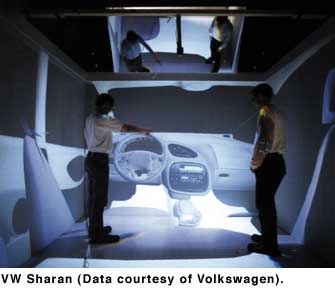
ERCIM News No.37 - April 1999
Virtual Environments support Interactive Engineering
by Gerold Wesche and Jürgen Wind
Special-purpose Virtual Environments, designed to fit the needs of 3D visualization and simulation applications, enter the research and development departments of the car industry. They do not only support engineers in their daily work, they also provide a useful platform for presentations to managers, to decision makers or to the public. GMD pioneered this work introducing a Virtual Environment called ‘Responsive WorkbenchTM’, a horizontal table-sized stereo projection system. Together with a tailor-made interface, it is the ideal workplace for 3D visualization and interactive steering applications.
The CyberStage, a CAVETM -like (CAVE Automatic Virtual Environment) Virtual Environment with an integrated eight-channel sound system and a sound floor, supports interior design studies, especially for car cabins. Interface design, ergonomics and inter-activity are the main research topics in this field of the GMD and its project partners or collaborators Daimler-Benz, BMW and Volkswagen. The visualization of the new Mercedes-Benz S-Class car cabin for the board of Daimler-Benz and the VW Sharan presentation in the CyberStage for Volkswagen are a proof-of-concept for the approaches developed to date.
3D visualization of Computational Fluid Dynamics, interactive steering of crash tests and interior design studies of car cabins are the main applications together that have been developed together with the car industry.
Visualization of Computational Fluid Dynamics
A 3D visualization application for fluid dynamics in Virtual Environments has been developed by GMD and Daimler-Benz AG. It supports the evaluation and exploration of huge simulation data sets in a highly interactive way. Visualization of the simulation data and interaction occur through the Responsive Workbench. The user specifies visualization parameters - such as insertion points for streamlines - using six degrees of freedom input devices.
These parameters are continuously sent from the Silicon Graphics computer to the computational server. In turn, the server rapidly computes high resolution visualization primitives, like streamlines or iso surfaces, and sends these back to the Silicon Graphics, where they are displayed at high frame rates.
Scalar volumes such as temperature or pressure fields, can be visualized using interactive cutting planes controlled by hand. The color coded temperature visualization is updated every frame without any noticeable latency. The intersection computation of the plane with a 3D texture is implemented in hardware. This visualization technique is even usable for unsteady fields. However, during the animation of the sequence the textures have to be reloaded into texture memory because the majority of the memory is filled with the data produced by one timestep. This may reduce the smoothness of the animations.
In a 3D environment, interactive cutting planes are also applicable for the visualization of velocity vectors. Small vector objects are computed in real time and emanate from the plane in the direction of the flow.
The system is running on a Responsive Workbench installation at Daimler-Benz, and it has been used for demonstrating the new Mercedes-Benz S-Class to members of the board of Daimler-Benz.
Interactive Steering of crash tests
Simulations of structural mechanics like crash tests benefit from the coupling of parallel numerical computation power and the rendering capabilities of a high-end graphics workstation. Adapting the interface or the Responsive Workbench to this application, a system has been built that integrates numerical simulation, 3D data exploration and interactive steering together with Virtual Reality techniques.
The major objective of this project is to evaluate the potentials and obstacles of interactive simulations. A parallel version of the PAM-CRASH simulation package from the European Software Institute, evaluating BMW´s crash tests, is running on a 12-processor SGI Onyx with InfiniteReality Graphics.
Interior design studies
The CyberStage as an immersive Virtual Environment is very suitable for the exploration of interior car designs. Easy orientation in space, head tracking and interactivity give a nearly perfect illusion of depth and three-dimensionality.

In a presentation for Volkswagen, the interior design of the VW Sharan model was a convincing experience for our collaborators. At their lab they set up their own version of a CyberStage installation.
Please contact:
Gerold Wesche - GMD
Tel: +49 2241 14 2708
E-mail: gerold.wesche@gmd.de
Jürgen Wind - GMD
Tel: +49 2241 14 2290
E-mail: juergen.wind@gmd.de